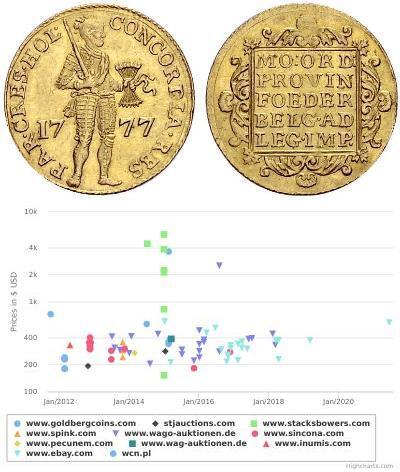1 Thaler Holy Roman Empire (962-1806) Silver
1619, Saxony-Old-Altenburg, John Philip. Large Silver “4-Brothers” Thaler Coin.
Mint Year: 1619
Mint Place. Saalfeld
Denomination: Thaler
Reference: Davenport 7367, KM-20.
Mint Master: Wolf Albrecht the Younger (W-A, 1612-1632)
Ruler: John Philip as Duke of Saxe-Altenburg and regent for this three younger brothers.
Weight: 28.65gm
Diameter: 44mm
Material: Silver
Obverse: Draped and armored bust of John Philip right. A tournament band bound round his shoulder and plummed helmet infront of him. Date (16-19) split in fields above.
Legend: D:G:IOH:PHIL: (lion) D:SAX:IVL:C (arms of Saxony / Thuringia) ET.ML:TH:M: (lion right) MCM.ET.R:D:R (cross-topped orb)
Reverse: Three armored busts of his his younger brothers Frederick, John William and Frederick William right.
Legend: D:G:FRID:IO. (shield) WI.&.FR:WIL: (two shields) F:R:S:L:T:M:M: (lion right) C.I:M:&:R:D:I:R (lion right)
Comment: Mintmaster’s initials W-A (Wolf Albrecth the Younger) flanking rosette above lower shields in exerque.
Saxe-Altenburg (German: Sachsen-Altenburg) was one of the Saxon duchies held by the Ernestine branch of the House of Wettin in present-day Thuringia. It was one of the smallest of the German states with an area of 1323 square kilometers and a population of 207,000 (1905) of whom about one fifth resided in the capital, Altenburg. The territory of the duchy consisted of two non-contiguous territories separated by land belonging to the Principality of Reuss-Gera. Its economy was based on agriculture, forestry, and small industry. The state had a constitutional monarchical form of government with a parliament composed of thirty members chosen by male taxpayers over 25 years of age.
John Philip, Duke of Saxe-Altenburg (b. Torgau, 25 January 1597 – d. Altenburg, 1 April 1639), was a duke of Saxe-Altenburg.
He was the eldest (but fourth in order of birth) surviving son of Frederick William I, Duke of Saxe-Weimar and Anna Marie of Bavaria-Neuburg, his second wife.
When his father died (1602), John Philip and his younger brothers Frederick, John William and Frederick William were underage. Because of this, his uncle John (more interested in natural sciences and art than politics) took over his guardianship and the regency of his inheritance; but shortly after he took all the duchy of Saxe-Weimar into his own hands.
The next year (1603), the young prince of Saxe-Weimar demanded his own inheritance, but his uncle John opposed this. But finally, both parts made a divisionary treaty of the family lands: John Philip and his brothers took Altenburg and some towns, and John retained Weimar and Jena.
Because they were still underage, the regency of his duchy was taken by Christian II, Elector of Saxony (1603–1611) and later by his brother and next Elector, John George I (1611–1618).
In 1618, John Philip, as elder son, was declared adult and assumed the government of the duchy of Saxe-Altenburg. Also, he took over the guardianship of his younger siblings. The four brothers co-ruled the duchy, but two of them died soon after and childless: Frederick, who was killed in action in 1625, and John William, died in Brieg on 1632.
John Philip and his only surviving brother, Frederick William II, continued as co-rulers; but, in fact, it was John Philip who really assumed the supreme and full control of the government until his death.
In 1613, John Philip was appointed Dean of the University of Leipzig. Also, he was an active member of the Fruitbearing Society.
In 1638, he received the towns of Coburg, Bad Rodach, Römhild, Hildburghausen and Neustadt, according to the divisionary treaty between him and the branch of Saxe-Weimar after the death of the duke John Ernest of Saxe-Eisenach without surviving issue.
Before his death, he made a will, when he declared his daughter the general heiress of the branch of Saxe-Altenburg, only in case of extinction of the male issue of the family. This will later originated a dispute between the branches of Saxe-Gotha and Saxe-Weimar.
John Philip was succeeded by his younger and only surviving brother, Frederick William II.
(740 X 376 pixels, file size: ~79K)
Posted by: anonymous 2020-11-23
1622,Sachsen-Altenburg. Johann Philipp und seine drei Brüder 1603-1625. Taler 1622, Saalfeld. Schnee 272, Davenport 7367. Randfehler, kleine Kratzer, sehr schön - vorzüglich.
(3205 X 1579 pixels, file size: ~968K)
Posted by: anonymous 2023-11-08
Untitled Document 1619, Saxony-Old-Altenburg, John Philip. Large Silver "4-Brothers" Thaler Coin. Mint Year: 1619 Mint Place. Saalfeld Denomination: Thaler Reference: Davenport 7367, KM-20. Mint Master: Wolf Albrecht the Younger (W-A, 1612-1632) Ruler: John Philip as ...
(1537 X 741 pixels, file size: ~289K)
Posted by: anonymous 2018-11-06
1619, Saxe-Old-Altenburg, John Philip. Silver "4-Brothers" Thaler Coin. PCGS AU+ Mint Year: 1619 Mint Place. Saalfeld Denomination: Silver Thaler Reference: Davenport 7367, KM-20. Mint Master: Wolf Albrecht the Younger (W-A, 1612-1632) Condition: Certified and graded by PCGS as AU (Deta ...
(1500 X 751 pixels, file size: ~220K)
Posted by: anonymous 2019-03-25
Sachsen-Altenburg. Johann Philipp und seine drei Brüder 1603-1625. Taler 1623, Saalfeld. Schnee 272, Davenport 7367. Schrötlingsfehler am Rand, etwas berieben, etwas Belag, sehr schön
(1500 X 743 pixels, file size: ~222K)
Posted by: anonymous 2019-05-08
Sachsen-Altenburg. Johann Philipp und seine drei Brüder 1603-1625. Taler 1623, Saalfeld. Schnee 272, Davenport 7367, Kernbach 4.14. Schöne Patina. Kleine Kratzer, kleine Randfehler, sehr schön +
(1500 X 762 pixels, file size: ~257K)
Posted by: anonymous 2019-05-08
Sachsen-Altenburg. Johann Philipp und seine drei Brüder 1603-1625. Taler 1622, Saalfeld. Schnee 272, Davenport 7367. Randfehler, kleine Kratzer, sehr schön - vorzüglich
40 coin descriptions were improved from 2025-05-21 to 2025-05-28
One of them is:
5 Yuan China Silver
group has 2 coins

-500-250-iiIQEYawA3cAAAGLR4kGka_K.jpg)
-300-150-w_D6O0Y9nXUAAAF16IxHfPbX.jpg)
-300-150-iiIQEYawA3cAAAGLR4kGka_K.jpg)
-300-150-BP4nA143yMIAAAFmLOxoDOec.jpg)
-300-150-W9nZGYbcawkAAAFpQiSZt7My.jpg)
-300-150-75l0WDeKG48AAAFqBCGVQJXR.jpg)
-300-150-UOR0WDeKkicAAAFqCeaVQJXQ.jpg)













